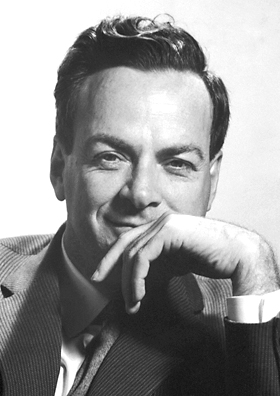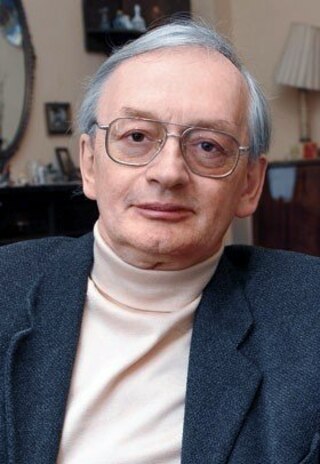Related Research Articles

Physics is the natural science of matter, involving the study of matter, its fundamental constituents, its motion and behavior through space and time, and the related entities of energy and force. Physics is one of the most fundamental scientific disciplines, with its main goal being to understand how the universe behaves. A scientist who specializes in the field of physics is called a physicist.

Richard Phillips Feynman was an American theoretical physicist, known for his work in the path integral formulation of quantum mechanics, the theory of quantum electrodynamics, the physics of the superfluidity of supercooled liquid helium, as well as his work in particle physics for which he proposed the parton model. For his contributions to the development of quantum electrodynamics, Feynman received the Nobel Prize in Physics in 1965 jointly with Julian Schwinger and Shin'ichirō Tomonaga.
A timeline of atomic and subatomic physics.

Steven Weinberg was an American theoretical physicist and Nobel laureate in physics for his contributions with Abdus Salam and Sheldon Glashow to the unification of the weak force and electromagnetic interaction between elementary particles.

Julian Seymour Schwinger was a Nobel Prize-winning American theoretical physicist. He is best known for his work on quantum electrodynamics (QED), in particular for developing a relativistically invariant perturbation theory, and for renormalizing QED to one loop order. Schwinger was a physics professor at several universities.

Shinichiro Tomonaga, usually cited as Sin-Itiro Tomonaga in English, was a Japanese physicist, influential in the development of quantum electrodynamics, work for which he was jointly awarded the Nobel Prize in Physics in 1965 along with Richard Feynman and Julian Schwinger.

John Archibald Wheeler was an American theoretical physicist. He was largely responsible for reviving interest in general relativity in the United States after World War II. Wheeler also worked with Niels Bohr to explain the basic principles of nuclear fission. Together with Gregory Breit, Wheeler developed the concept of the Breit–Wheeler process. He is best known for popularizing the term "black hole" for objects with gravitational collapse already predicted during the early 20th century, for inventing the terms "quantum foam", "neutron moderator", "wormhole" and "it from bit", and for hypothesizing the "one-electron universe". Stephen Hawking called Wheeler the "hero of the black hole story".

Leonard Mlodinow is an American theoretical physicist and mathematician, screenwriter and author. In physics, he is known for his work on the large N expansion, a method of approximating the spectrum of atoms based on the consideration of an infinite-dimensional version of the problem, and for his work on the quantum theory of light inside dielectrics.

In particle physics, the history of quantum field theory starts with its creation by Paul Dirac, when he attempted to quantize the electromagnetic field in the late 1920s. Major advances in the theory were made in the 1940s and 1950s, leading to the introduction of renormalized quantum electrodynamics (QED). The field theory behind QED was so accurate and successful in predictions that efforts were made to apply the same basic concepts for the other forces of nature. Beginning in 1954, the parallel was found by way of gauge theory, leading by the late 1970s, to quantum field models of strong nuclear force and weak nuclear force, united in the modern Standard Model of particle physics.

John R. Gribbin is a British science writer, an astrophysicist, and a visiting fellow in astronomy at the University of Sussex. His writings include quantum physics, human evolution, climate change, global warming, the origins of the universe, and biographies of famous scientists. He also writes science fiction.
The first Shelter Island Conference on the Foundations of Quantum Mechanics was held from June 2–4, 1947 at the Ram's Head Inn in Shelter Island, New York. Shelter Island was the first major opportunity since Pearl Harbor and the Manhattan Project for the leaders of the American physics community to gather after the war. As Julian Schwinger would later recall, "It was the first time that people who had all this physics pent up in them for five years could talk to each other without somebody peering over their shoulders and saying, 'Is this cleared?'"

Robert Eugene Marshak was an American physicist, educator, and eighth president of the City College of New York.
Marcus Chown is a science writer, journalist and broadcaster, currently cosmology consultant for New Scientist magazine.

The Feynman Lectures on Physics is a physics textbook based on a great number of lectures by Richard Feynman, a Nobel laureate who has sometimes been called "The Great Explainer". The lectures were presented before undergraduate students at the California Institute of Technology (Caltech), during 1961–1963. The book's co-authors are Feynman, Robert B. Leighton, and Matthew Sands.
The Pocono Conference of 30 March to 2 April 1948 was the second of three postwar conferences held to discuss quantum physics; arranged by Robert Oppenheimer for the National Academy of Sciences. It followed the Shelter Island Conference of 1947 and preceded the Oldstone Conference of 1949.

Alexei Alexandrovich Starobinsky was a Soviet and Russian theoretical physicist and cosmologist. He was a pioneer of the theory of cosmic inflation, for which he received the 2014 Kavli Prize in Astrophysics together with Alan Guth and Andrei Linde.
Jagdish Mehra was an Indian–American physicist and historian of science.
References
- Gribbin, John & Mary (1997). Richard Feynman: A Life in Science. England: Viking Press. p. 118. ISBN 0-670-87245-8.
- Metra, Jagdish (1994). The Beat of a Different Drum: The life and science of Richard Feynman. Oxford, England: Clarendon Press. pp. 278–279. ISBN 0-19-853948-7.